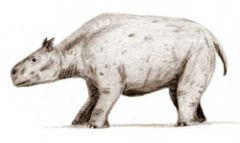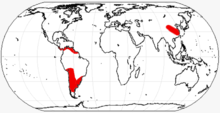- Notoungulata
-
Notoungulata
Temporal range: Paleocene–Pleistocene
Toxodon platensis Scientific classification Kingdom: Animalia Phylum: Chordata Class: Mammalia Infraclass: Eutheria Superorder: †Meridiungulata Order: †Notoungulata
Roth, 1903Suborders and Families 
Range of Notoungulata based on fossil record Notoungulata is an extinct order of hoofed, sometimes heavy bodied mammalian ungulates which inhabited South America during the Paleocene to Pleistocene, living from approximately 57 Ma to 11,000 years ago.[1]
Contents
Taxonomy
Notoungulata was named by Roth (1903). It was assigned to Eutheria by Carroll (1988).[2] Due to the isolated nature of South America, many notoungulates evolved along convergent lines into forms that resembled mammals on other continents. Examples of this are Pachyrukhos, a notoungulate that evolved to fill the role of rabbits and hares and Homalodotherium, which evolved to resemble chalicotheres. During the Pleistocene, Toxodon was the largest common notoungulate. Most of the group (Toxodon being an exception) became extinct after the landbridge between North and South America was formed, allowing North American ungulates to enter South America in the Great American Interchange and out-compete the native fauna. This order is united with other South-American ungulates in the super-order Meridiungulata.
Cifelli has argued that Notioprogonia is paraphyletic, as it would include the ancestors of the remaining suborders. Similarly, Cifelli indicated that Typotheria would be paraphyletic if it excluded Hegetotheria and he advocated inclusion of Archaeohyracidae and Hegetotheriidae in Typotheria.[3]
As reflected in the map that accompanies this article, Notoungulata were for many years taken to include the order Arctostylopida, whose fossils are found mainly in China. Recent studies, however, have concluded that Arctostylopida are more properly classified as gliriforms, and that the notoungulates were therefore never found outside South and Central America.[4]
Orders and families
- Order Notoungulata - notoungulates
- Suborder Notioprogonia
- Family Henricosborniidae
- Family Notostylopidae
- Suborder Toxodonta
- Family Isotemnidae
- Family Leontiniidae
- Family Notohippidae
- Family Toxodontidae
- Family Homalodotheriidae
- Suborder Typotheria
- Family Archaeopithecidae
- Family Oldfieldthomasiidae
- Family Interatheriidae
- Family Campanorcidae
- Family Mesotheriidae
- Suborder Hegetotheria
- Family Archaeohyracidae
- Family Hegetotheriidae
- Suborder Notioprogonia
References
Footnotes
- ^ Paleobiology Database: Notoungulata, Basic info.
- ^ R. L. Carroll. 1988. Vertebrate Paleontology and Evolution. W.H. Freeman and Company
- ^ Cifelli, Richard L. 1993. The phylogeny of the native South American ungulates. pp. 195-216 in F. S. Szalay, M. J. Novacek and M. C. McKenna (eds.) Mammal Phylogeny, Volume 2, Placentals. Springer-Verlag, New York. ISBN 0-387-97853-4
- ^ Missiaen P, Smith T, Guo DY, Bloch JI, Gingerich PD (August 2006). "Asian gliriform origin for arctostylopid mammals". Naturwissenschaften 93 (8): 407–11. doi:10.1007/s00114-006-0122-1. PMID 16865388.
Notations
- McKenna, Malcolm C., and Bell, Susan K. 1997. Classification of Mammals Above the Species Level. Columbia University Press, New York, 631 pp. ISBN 0-231-11013-8
Categories:- Notoungulates
- Prehistoric animals of South America
- Paleocene mammals
- Miocene mammals
- Pliocene mammals
- Oligocene mammals
- Pleistocene mammals
- Pleistocene extinctions
- Order Notoungulata - notoungulates
Wikimedia Foundation. 2010.
